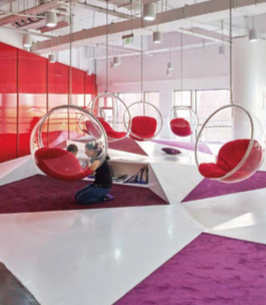Call 22: Build wellbeing into the design of our learning spaces to show young people they are truly valued
By Diarmaid Lawlor
Equity and excellence drive education in Scotland. They influence how we choose to close the attainment gap, design the curriculum and empower teachers. They underpin how we try to get it right, for all young people.
The foundation of learning is wellbeing. Healthy social and emotional development in childhood and adolescence has been shown to be positively associated with better educational outcomes. The quality of our environments directly affects the experience of wellbeing.
Often we find young people have negative experiences of spaces in school, with a common complaint being there aren’t enough social spaces to gather and build relationships. The results can be disengagement, disaffection or a sense of not feeling safe, affecting mental health, behaviour and attitudes – as well as learning.
To achieve excellence and equity in young people’s experiences across the learning estate, we need to make more of the spaces we already have, and design new environments to better respond to changing wellbeing needs.
Schools and local authorities regularly assess the suitability of spaces for learning using guidance set out in the Scottish Government's Core Fact on the suitability of the school estate.
We call for collective leadership between learners, educationalists and local authority asset teams to drive improvements in social spaces to better support wellbeing using evidence from the Core Fact assessments.
‘Design for wellbeing’ should be a key element of all school improvement plans across the country, at all stages of learning, supported by an evidence-based approach to impact.
To achieve this ambition, we suggest a series of measures. First, more participation by young people in the decision-making around changing and managing spaces in schools, as part of the client team on management and investment.
We need to listen to what it is they want, and respond appropriately. We also need more spaces within schools and learning spaces allocated to learner needs. This will involve creative thinking, and challenge to old patterns of use, to create new multipurpose spaces, more social spaces, more and different learning settings and more places young people can feel relaxed to be themselves. In addition, diversifying the range of spaces within schools will help to better manage transitions between learning stages, enabling learners to make decisions with confidence, adapt spaces to their needs, and find retreat and support spaces as they need.
As part of this we should be re-thinking our use of the outdoors, recognising its role as a space for wellbeing and learning and enabling more learner led opportunities in these settings. We need to build on evidence, linking to the Scottish Public Service Improvement cycle, supported by the low-cost Tests of Change project by Architecture & Design Scotland to drive more and better inspiring spaces.
All of this requires a radical change in our thinking and our approach, but ensuring consideration and understanding of design and space is a key element of teacher and practitioner training, and Career-long Professional Learning, will help to cement the long-term approach we need.
Young people who took part in design workshops run by Architecture & Design Scotland told us: “(We need) a building that allows independence and choice.”
“(We need) a good place to go and talk to your friends.”
“Social space is important for our mental health.”
We owe it to them to listen.
Follow #25Calls to see which organisations have endorsed this call.
Article 24 – United Nations Convention on the Rights of the Child: '...the right to good quality health care, to clean water and good food...'

25 Calls
Return to the main 25 Calls page to find out what change others are calling for
Visit the pageArchitecture & Design Scotland
Find out more about A&DS, whose purpose is to promote the value of good architecture and sustainable design
Visit the websiteUnited Nations Convention on the Rights of the Child
Article 24: "...the right to good quality health care, to clean water and good food."
Learn more